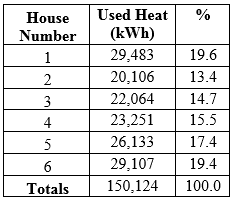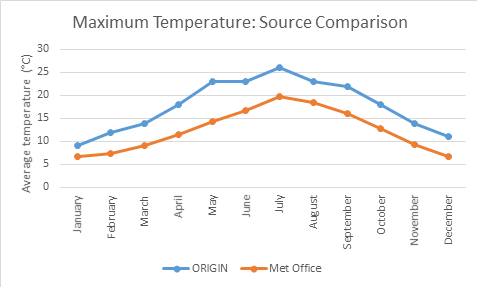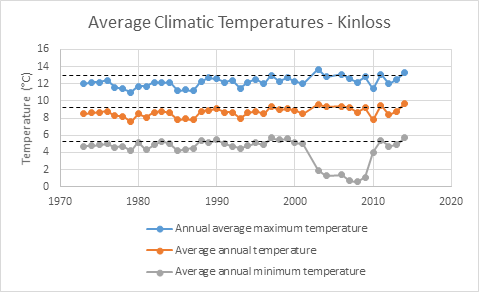determine demand
The initial intention was to use data from the ORIGIN Project to extrapolate the heat demand profile for the Soillse housing district (including both space and hot water heating), then apply our developed solar thermal calculation tool to approximate solar thermal contributions at a nearby location and subtract these from the overall demand profile to arrive at the quantity of heat supplied solely by biomass which would be eligible for Non-Domestic RHI payments. Unfortunately, the ORIGIN Project has not been collecting data for a sufficient period of time for credible use. The results of the ORIGIN Project were therefore used as a preliminary point of reference, but discarded upon receiving accurate data from a technical contact. This was provided for the period 6.1.2013 - 6.1.2015 for the six houses within the Soillse housing district. In consideration of this data being approved by Ofgem and relevant governmental bodies, it may be taken as 100% credible for the purpose of a retrospective financial feasibility analysis, with results that may be applied with reliable, real life quantitative vindication.
Table 1. Used Soillse heat over the period 6.1.2013 - 6.1. 2015.
One question which must be considered however, is how representative is this data taken over only a two year period of the climate conditions etc. which may be expected over the entire lifetime of these specific renewable heating technologies, in the region of twenty years or so? Specifically, how closely did climatic conditions reflect that of a design year as extrapolated from an archived weather database of sufficient size?
The climatic conditions are a critical factor for two pertinent reasons. Firstly, the density of solar energy for any given year obviously determines the quantity of solar thermal heating contributions into the central thermal tank. This by subtraction determines the quantity of biomass fuel which must be burned to satisfy the comparative deficit to demand. And secondly, along a similar line of argument, the ambient temperature over our two year period will inevitably determine the heat demand profile. We must therefore identify a suitable means of comparing the used climate conditions with typical behaviour over a sufficient period of time. We looked at the possibility of using the Met Office’s climate data archives for Kinloss (the nearest weather station to Findhorn ecovillage) from 1981-2010 to compare with ORIGIN data available for 2014 from Kinloss Weather Station [1]. The results of this are presented in the figures below. After analysis of the perceived obscurity of specific results, and with concerns over the reliability of ORIGIN data as discussed above, it was decided to pursue an alternative method.
The climatic conditions are a critical factor for two pertinent reasons. Firstly, the density of solar energy for any given year obviously determines the quantity of solar thermal heating contributions into the central thermal tank. This by subtraction determines the quantity of biomass fuel which must be burned to satisfy the comparative deficit to demand. And secondly, along a similar line of argument, the ambient temperature over our two year period will inevitably determine the heat demand profile. We must therefore identify a suitable means of comparing the used climate conditions with typical behaviour over a sufficient period of time. We looked at the possibility of using the Met Office’s climate data archives for Kinloss (the nearest weather station to Findhorn ecovillage) from 1981-2010 to compare with ORIGIN data available for 2014 from Kinloss Weather Station [1]. The results of this are presented in the figures below. After analysis of the perceived obscurity of specific results, and with concerns over the reliability of ORIGIN data as discussed above, it was decided to pursue an alternative method.
Figure 1. Average monthly maximum temperature for Kinloss from Figure 2. Average monthly minimum temperature for Kinloss from
1981-2010 (Met Office) and January 2014-2015 (ORIGIN Project). 1981-2010 (Met Office) and January 2014-2015 (ORIGIN Project).
1981-2010 (Met Office) and January 2014-2015 (ORIGIN Project). 1981-2010 (Met Office) and January 2014-2015 (ORIGIN Project).
Reference [2] maintains a climate database for an extensive list of worldwide locations. This includes a highly useful climate database for Kinloss from 1973-2015. Although this data source records a range of climatic parameters including number of foggy days, days with rain, snow etc. it does not unfortunately record the number of sunny days or solar concentrations, nor any source located on the web. We can however use the average climatic temperatures for Kinloss to make a qualitatively accurate deduction on whether the period 6th January 2013 – 6th January 2015 is reasonably representative of the typical design year conditions. Results presented in the figure below.
Figure 3. Average climatic temperatures in Kinloss. Black dashed lines correspond to average
temperature over our period of interest, providing comparison to typical climate over 30 years.
temperature over our period of interest, providing comparison to typical climate over 30 years.
As can be seen from dashed lines in the Figure above, the period of 1st January 2013 (i.e. 6th January 2013) – 31st December 2014 (i.e. 6th January 2015) is approximately consistent with average climatic behaviour, in reference to temperature anyway. It would therefore be proposed reasonable to assume that the Soillse housing district heat demand and equivalent fuel supply data forwarded by a technical contact, are suitable to use as average quantities in a financial feasibility analysis extending over a prolonged period of time.
Despite all the analysis above examining whether the provided range of data is suitably representative of average climatic conditions and therefore credible for communicating significant results on the financial feasibility of integrated biomass-solar thermal district heating systems, there is no other data available to use anyway. If there was a sufficiently extreme deviation from average climatic behaviour, the financial feasibility analysis to follow would have to apply appropriately identified scaling factors to gain more reliably useable data. However it was concluded from all of the above that such a potentially intricate procedure would not be necessary, and that all data provided by our technical contact over the period 6th January 2013 – 6th January 2015 is suitable to use as average quantities in a financial feasibility analysis extending over a prolonged period of time matching expected technology lifetimes.
Despite all the analysis above examining whether the provided range of data is suitably representative of average climatic conditions and therefore credible for communicating significant results on the financial feasibility of integrated biomass-solar thermal district heating systems, there is no other data available to use anyway. If there was a sufficiently extreme deviation from average climatic behaviour, the financial feasibility analysis to follow would have to apply appropriately identified scaling factors to gain more reliably useable data. However it was concluded from all of the above that such a potentially intricate procedure would not be necessary, and that all data provided by our technical contact over the period 6th January 2013 – 6th January 2015 is suitable to use as average quantities in a financial feasibility analysis extending over a prolonged period of time matching expected technology lifetimes.




